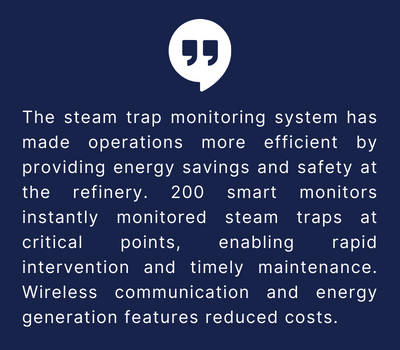Steam Management in an Oil Refinery: Increasing Efficiency with BrenPower

 Challenge
Challenge
Oil refineries are complex facilities that process crude oil and convert it into various products using steam in various processes. Steam is an essential part of many critical processes such as distillation, cracking, hydrogen production, processing units, heating, power generation, washing and cleaning. However, manually monitoring and maintaining thousands of steam traps in large plants is a challenging task. Since oil refineries are areas where explosive gas leaks can occur, running supply and data cables for each piece of equipment is very costly and not feasible.The main challenge for the refinery is the need to monitor and maintain thousands of steam traps instantaneously. Difficulties in manual inspections lead to problems such as failure to quickly identify problems at critical points and overlooking potential savings in energy costs.
Solution
To overcome these challenges and effectively manage the steam traps, the refinery decided to adopt a smart solution, the steam trap monitoring system. The fact that it is self-powered and wireless reduces the risks that may arise within the refinery and provides ease of implementation made it a good choice. In the first phase, smart monitors were installed on 200 steam traps located at critical and difficult access points of the plant. These points were identified as those with difficult access and critical importance. The monitors instantly monitored these 200 pieces of equipment, providing instant alerts to maintenance teams and enabling predictive maintenance to be carried out on time.
 Benefits
Benefits
- Significant energy cost savings were achieved through the immediate availability of fault alerts.
- Safety was increased with cold steam trap notifications to prevent equipment freezing during cold winter months.
- Thanks to artificial intelligence-supported plans, failures other than leaks were detected and intervened.
- The lack of revisions in operations and the fact that production did not stop provided a great advantage.
- The fact that the device generates its own energy saves battery costs and prevents cable pulling.
- Wireless communication saved meters of data cables.

